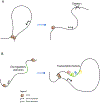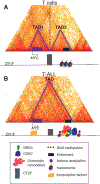Determinants and role of chromatin organization in acute leukemia - PubMed
- ️Invalid Date
Review
Determinants and role of chromatin organization in acute leukemia
Celestia Fang et al. Leukemia. 2020 Oct.
Abstract
DNA is compacted into higher order structures that have major implications in gene regulation. These structures allow for long-range interactions of DNA elements, such as the association of promoters with their cognate enhancers. In recent years, mutations in genes that control these structures, including the cohesin-complex and the insulator-binding protein CTCF, have been found in a spectrum of hematologic disorders, and especially in acute leukemias. Cohesin and CTCF are critical for mediating looping and establishing boundaries within chromatin. Cells that harbor mutations in these genes display aberrant chromatin architecture and resulting differences in gene expression that contribute to leukemia initiation and progression. Here, we provide detailed discussion of the nature of 3D interactions and the way that they are disrupted in acute leukemia. Continued research in this area will provide new insights into the mechanisms of leukemogenesis and may shed light on novel treatment strategies.
Conflict of interest statement
Conflicts of Interest
The authors declare no conflicts of interests.
Figures

a Schematic of a typical promoter:enhancer interaction. These intra-TAD interactions occur when the intervening chromatin segments (black line) are “looped out” to allow the enhancer (green) and promoter (light blue) to directly interact within the nucleus, thereby facilitating gene expression (Dark Blue). Transcription factors (TFs, purple) bind both promoters and enhancers, ultimately resulting in RNA Pol II (Pol II, yellow) producing an mRNA. Active promoters and enhancer can be identified through shared (H3K27Ac) and distinct (H3K4me3-promoters, H3K4me1-enhancers) marks. These interactions are facilitated by CTCF (orange) and/or cohesin (gray). b Schematic of the cohesin complex. Three invariant core subunits (SMC3, SMC1A, and RAD21) and a variable subunit (typically STAG1 or STAG2) form a ring which effectively “handcuffs” the chromatin loop.

a A pair of CTCF sites can anchor a loop required for active gene expression (left). Deletion of one CTCF site prevents loop formation, thus abrogating gene expression (right). b Silenced genes (left) can require binding of multiple transcription factors to cis-regulatory elements shown in blue. Transcription factor binding induces looping and active gene expression (right).

a In normal T cells, the MYC gene is expressed at low levels and is separated from its enhancers by a TAD boundary (demarcated by CTCF binding). b Binding of oncogenic transcription factors such as NOTCH1 and GATA3 as well as recruitment of chromatin remodelers and histone acetylation in the enhancer areas lead to enhancer activation and extensive three-dimensional contacts between the enhancer and MYC in T-cell leukemia upon loss of CTCF from the TAD boundary.
Similar articles
-
A tour of 3D genome with a focus on CTCF.
Wang DC, Wang W, Zhang L, Wang X. Wang DC, et al. Semin Cell Dev Biol. 2019 Jun;90:4-11. doi: 10.1016/j.semcdb.2018.07.020. Epub 2018 Jul 23. Semin Cell Dev Biol. 2019. PMID: 30031214 Review.
-
Shin HY. Shin HY. Genes Genomics. 2019 Mar;41(3):257-265. doi: 10.1007/s13258-018-0768-z. Epub 2018 Nov 19. Genes Genomics. 2019. PMID: 30456521 Review.
-
Loguercio S, Barajas-Mora EM, Shih HY, Krangel MS, Feeney AJ. Loguercio S, et al. Front Immunol. 2018 Mar 8;9:425. doi: 10.3389/fimmu.2018.00425. eCollection 2018. Front Immunol. 2018. PMID: 29593713 Free PMC article.
-
Luo H, Wang F, Zha J, Li H, Yan B, Du Q, Yang F, Sobh A, Vulpe C, Drusbosky L, Cogle C, Chepelev I, Xu B, Nimer SD, Licht J, Qiu Y, Chen B, Xu M, Huang S. Luo H, et al. Blood. 2018 Aug 23;132(8):837-848. doi: 10.1182/blood-2017-11-814319. Epub 2018 May 14. Blood. 2018. PMID: 29760161 Free PMC article.
-
CTCF mediates chromatin looping via N-terminal domain-dependent cohesin retention.
Pugacheva EM, Kubo N, Loukinov D, Tajmul M, Kang S, Kovalchuk AL, Strunnikov AV, Zentner GE, Ren B, Lobanenkov VV. Pugacheva EM, et al. Proc Natl Acad Sci U S A. 2020 Jan 28;117(4):2020-2031. doi: 10.1073/pnas.1911708117. Epub 2020 Jan 14. Proc Natl Acad Sci U S A. 2020. PMID: 31937660 Free PMC article.
Cited by
-
Long noncoding RNAs: emerging regulators of normal and malignant hematopoiesis.
Qiu Y, Xu M, Huang S. Qiu Y, et al. Blood. 2021 Dec 9;138(23):2327-2336. doi: 10.1182/blood.2021011992. Blood. 2021. PMID: 34482397 Free PMC article. Review.
-
Nandanpawar P, Sahoo L, Sahoo B, Murmu K, Chaudhari A, Pavan Kumar A, Das P. Nandanpawar P, et al. Front Genet. 2023 Jun 8;14:1153911. doi: 10.3389/fgene.2023.1153911. eCollection 2023. Front Genet. 2023. PMID: 37359361 Free PMC article.
-
Yao Y, Huang T, Wang Y, Wang L, Feng S, Cheng W, Yang L, Duan Y. Yao Y, et al. J Enzyme Inhib Med Chem. 2022 Dec;37(1):652-665. doi: 10.1080/14756366.2022.2032688. J Enzyme Inhib Med Chem. 2022. PMID: 35109719 Free PMC article.
-
Human VDAC pseudogenes: an emerging role for VDAC1P8 pseudogene in acute myeloid leukemia.
Pappalardo XG, Risiglione P, Zinghirino F, Ostuni A, Luciano D, Bisaccia F, De Pinto V, Guarino F, Messina A. Pappalardo XG, et al. Biol Res. 2023 Jun 22;56(1):33. doi: 10.1186/s40659-023-00446-1. Biol Res. 2023. PMID: 37344914 Free PMC article.
-
Tarquino J, Arabyarmohammadi S, Tejada RE, Madabhushi A, Romero E. Tarquino J, et al. Cytometry A. 2023 Nov;103(11):857-867. doi: 10.1002/cyto.a.24785. Epub 2023 Aug 26. Cytometry A. 2023. PMID: 37565838 Free PMC article.
References
-
- Lupiáñez DG, Spielmann M, Mundlos S. Breaking TADs: How Alterations of Chromatin Domains Result in Disease. Trends in Genetics 2016. 2016/04/01/; 32(4): 225–237. - PubMed
-
- Dekker J, Rippe K, Dekker M, Kleckner N. Capturing chromosome conformation. Science 2002. February 15; 295(5558): 1306–1311. - PubMed
Publication types
MeSH terms
Substances
Grants and funding
LinkOut - more resources
Full Text Sources
Medical
Molecular Biology Databases